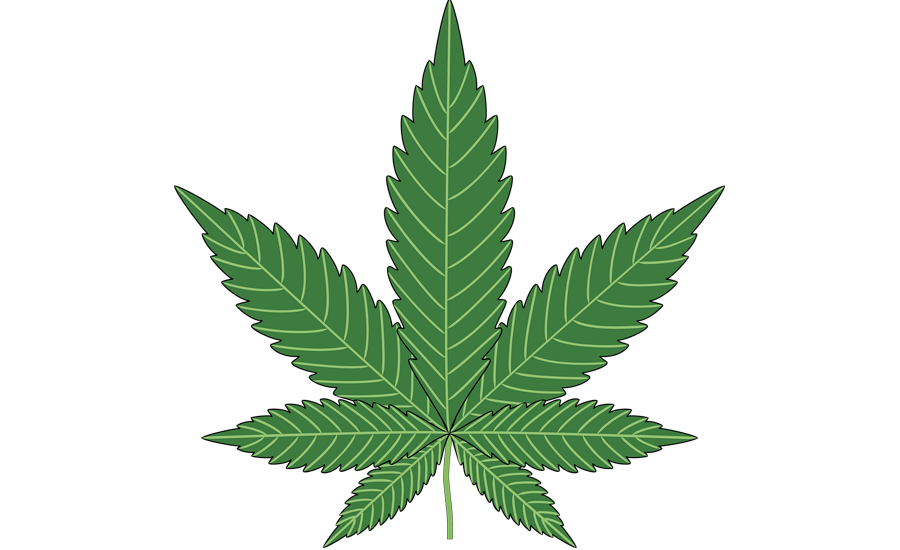Before we try to clear the smoke on the issue of medical marijuana, we should first put the subject in its proper context. Regardless of the strength of the arguments in favor of or against medical marijuana usage, its use in the workplace is primarily a safety issue. Prudent construction employers have always made safety a priority, and they now have a new safety threat: the expanding use of medical marijuana and the expanding cultural expectation that employees should be allowed to light up any time because of health issues.
Construction’s “Fatal Four” workplace injury types
Construction sites are inherently hazardous. In 2015, of 4,379 private industry fatalities, 937 (21.4%) were in construction.1 OSHA’s “Fatal Four” in the construction industry are:
- Falls — 364 out of 937 total deaths in construction in CY 2015 (38.8%)
- Struck by Object - 90 (9.6%)
- Electrocutions - 81 (8.6%)
- Caught-in/between* - 67 (7.2%)
(*This category includes construction workers killed when caught-in or compressed by equipment or objects, and struck, caught, or crushed in collapsing structure, equipment, or material)
Marijuana’s negative effects
Construction workers must have full use of their skills and faculties while performing their jobs. Medical marijuana may have positive medical benefits, but there are also well-documented negative effects. Some negative effects to the central nervous system include changes in sensory perception, altered thought formation and expression, short-term memory problems, and impaired thinking and learning. Negative physical effects include impaired motor performance, loss of balance and coordination, decreased attentiveness and alertness, prolonged response time to stimuli and danger, decreased ability to judge distance and space, and impaired ability to perform complex tasks.
These negative effects could be disastrous on a job site. Unlike most other drugs, prescription or otherwise, the problem with medical marijuana is in determining whether an employee is potentially subject to these negative effects on a jobsite. Currently, there is no reliable metric for determining when a particular level of THC from marijuana usage impairs the user and for how long that user remains impaired. THC and other psychoactive components stay in the body much longer than alcohol. Studies regarding the duration of impairment show the duration of impairment from marijuana use may be longer than previously known and could be up to 24 to 48 hours. Chronic use of marijuana may have long-term brain effects that could impair construction workers even if they are not actively smoking on the jobsite.
Expanding use of medical marijuana
Marijuana usage is broad-based, particularly with younger Americans. In a recent survey, 31.6% of people 18-25 used marijuana in 2013. But, the largest growth among marijuana users is in the 55 – 64 age group with an increase of 455% from 2002 to 2014.
Marijuana laws vary widely state to state. Of states that have medical or recreational marijuana use, some expressly allow employers to enforce their drug-free workplace policies, including CA, CO, DE, IL, MT, NV, NH, and WA). Some have anti-discrimination provisions for lawful use outside the workplace, including AR, AZ, CT, DE, IL, ME, MN, NY, NV, PA, and RI. In my home state of Florida, we still do not have details for our soon-to-be implemented voter-approved constitutional amendment.
Isn’t marijuana still illegal?
Yes marijuana use (medical or recreational) is still technically illegal under federal law because marijuana is a Schedule I Narcotic under the Controlled Substances Act. Under the CSA, it is illegal to manufacture, sell, distribute, or possess marijuana. No DEA-certified physician may prescribe marijuana. Medical marijuana is illegal under federal law as a controlled substance. However, 28 states have passed laws authorizing the medical use of marijuana.2 The most recent is my home state of Florida. Although there is generally no legal protection for use, possession, or intoxication at work, the expansive adoption of medical marijuana laws by the states poses significant legal and practical issues for construction industry employers who value safety.
OSHA’s General Duty Clause
OSHA does not have a specific standard that prohibits drug use or impairment from drug use on a job site. OSHA also does not expressly prohibit post-accident drug testing. Many states’ workers’ compensation statutes actually require post-accident drug testing to earn premium discounts. However, the General Duty Clause, Section 5(a)(1) of the OSH Act, may be applicable: “Each employer shall furnish to each of [its] employees employment and a place of employment which are free from recognized hazards that are causing or are likely to cause death or serious physical harm to [its] employees.” The General Duty Clause is intended to protect employees when there is no particular standard that applies. For example, OSHA has targeted such recognized unregulated workplace hazards as combustible dust and internal traffic control plans in highway work zones. To prevail on a General Duty Clause, OSHA must establish the following elements:
a. The employer failed to keep the workplace free of a hazard to which employees of that employer were exposed;
b. The hazard was recognized;
c. The hazard was causing or was likely to cause death or serious physical harm; and
d. There was a feasible and useful method to correct the hazard.
It’s conceivable OSHA could attempt to use the General Duty Clause if a medical marijuana use is a factor in a workplace accident. Time will tell.
OSHA’s controversial post-accident drug-testing “rule”
In May 2016, OSHA announced a new electronic record-keeping rule that contained what many interpreted as an attempt to prohibit post-accident drug testing. OSHA originally stated that the test must measure impairment at the time of the injury. OSHA later clarified and said it “will only consider whether the drug test is capable of measuring impairment at the time the injury or illness occurred where such a test is available.” “OSHA will consider this factor for tests that measure alcohol use, but not for tests that measure the use of any other drugs.” In light of this language, employers can expect to discipline employees based on positive drug tests for marijuana and other drugs where the test is not capable of measuring the level of impairment at the time of the injury. As of this article, implementation of the “rule” has been delayed and is in doubt. Regardless, post-accident drug testing is seen by many safety professionals and construction industry employers as an important and critical element to maintaining a safe workplace.
The Drug-Free Workplace Act (DFWA)
The federal DFWA applies to certain federal contractors and grant recipients, but the misunderstandings about the DFWA’s scope and requirements far exceed its actual requirements. First, the DFWA does not require drug testing in the workplace. It does not require employers to fire employees for a positive drug test. All it requires is a continuous good faith effort to maintain a drug-free workplace by publishing or distributing a policy, specifying actions for policy violations, providing education about drug use and employee assistance programs. For most employers, if they are complying with state drug-free workplace statutes, they will have gone above and beyond DFWA’s requirements. The law really provides no meaningful guidance on medical marijuana.
Must an employer accommodate medical marijuana usage?
Not yet. One of the key questions presented by medical marijuana laws is whether an employer must accommodate an employee’s medical usage. In Ross v. Raging Wire Telecomm., Inc., 42 Cal.4th 920 (Ca. 2008), an applicant for employment tested positive for marijuana and told his prospective employer he used marijuana for medical reasons. There was no issue in the case about on-site or working time marijuana use. The California Supreme Court held California law did not require the employer to accommodate any employee’s on or off premises medical marijuana usage and it could conduct pre-employment drug testing. The Ross decision is not without controversy and has been cited and criticized, so it is not likely to remain the last word on these issues. Accommodations could include permitting a positive drug test result, granting more flexible leave (such as intermittent FMLA leave), or job transfers (out of safety sensitive positions).
On June 9, 2017, the Florida Legislature sent a bill to Governor Rick Scott implementing the Florida Medical Marijuana Legalization Initiative, which voters approved in November 2016. (SB 8-A).3 The bill will be effective upon Gov. Scott’s signing the bill, which he has said he “absolutely” will sign, and will take effect upon becoming a law. The amendment states that laws must be in place by July 3, 2017, and enacted by October of 2017. Scott should be able to sign the bill ahead of the first deadline.
While many aspects of the bill have been covered in other publications, the most important section of the bill for Florida employers has received scant attention. Section 381.986 of the Florida Statutes has been amended to provide:
This section does not limit the ability of an employer to establish, continue, or enforce a drug-free workplace program or policy. This section does not require an employer to accommodate the medical use of marijuana in any workplace or any employee working while under the influence of marijuana. This section does not create a cause of action against an employer for wrongful discharge or discrimination. Marijuana, as defined in this section, is not reimbursable under chapter 440.
Court challenges are likely, most certainly on the aspect of the legislation that precludes actual smoking of marijuana. It is unclear what the result of a court challenge would be on the section that excludes smoking. The constitutional amendment provides that “[n]othing in this section shall require any accommodation of any on-site medical use of marijuana in any correctional institution or detention facility or place of education or employment, or of smoking medical marijuana in any public place.”
In any event, the legislation gives Florida employers some degree of protection if they do not want intoxicated employees on their worksites. This is also consistent with the federal Department of Transportation rule that medical review officers will not verify a drug test as negative based upon information that a physician recommended that the employee use medical marijuana. Under those rules, “[i]t remains unacceptable for any safety‐sensitive employee subject to drug testing under the Department of Transportation’s drug testing regulations to use marijuana.”
What have courts said about drug-free workplaces and medical marijuana?
There have been relatively few reported cases regarding marijuana use. The most often discussed are from Colorado and California. In Coats v. Dish Network, LLC, the Colorado Supreme Court held the termination of an employee for off-duty, medical marijuana use was lawful. 350 P.3d 849 (Co. 2015). The employee worked in a job that was not safety-sensitive. He failed a random drug test under the company’s “zero tolerance” drug-free workplace policy and was terminated. The employee argued Colorado’s Lawful Activities Act prohibited his termination for “engaging in any lawful activity off the premises of the employer during nonworking hours.” The Court held that under the Lawful Activities Act, the “lawful” activity must be legal under state and federal law and that marijuana remained illegal under the federal Controlled Substances Act. The Coats decision’s potential impact is widespread because 35 states have lawful off-duty conduct statues similar to Colorado’s Lawful Activities Act (e.g., California Labor Code § 96(k).) Although the case is not binding on other states’ courts, it could be persuasive.4
Conclusion — What should contractors do now?
Medical marijuana is a safety issue. Prudent employers will treat it that way and not let down their guard to this expanding job site risk. Construction industry employers should take the following actions:
- Remind employees that on-the-job impairment is not tolerated and that medical marijuana is no exception (see below sample policy).
- Update your drug-free workplace policy and drug-testing policy and procedures (see below sample policy for one component)
- Provide employee education on company policies and impact of legal changes (with emphasis on safety!)
- Train supervisors and managers on how to spot issues that may need further consideration.
- Offer employee assistance where appropriate (e.g., for serious health conditions under the FMLA or disabilities under the ADA).
Sample Policy Language for Construction Industry Employers:
Your Safety and Marijuana Usage
ConstructCo puts safety first. The safety of our employees, other contractors’ employees, and the general public is our highest priority. Although many states have recently passed laws attempting to legalize medical and recreational marijuana usage, marijuana usage for any purpose remains illegal under federal law and is a serious risk to health and safety on a construction site. ConstructCo strictly prohibits illegal drug possession, use, or impairment, and medical marijuana is no exception, even if a state as a medical marijuana law. ConstructCo intends to follow all state and federal laws, but where they conflict, the company will follow the stricter federal law.
Endnotes
1. United States Department Of Labor, Occupational Safety and Health Administration, https://www.osha.gov/oshstats/commonstats.html (last visited May 25, 2017).
2. As of this writing, eight states and the District of Columbia (AK, CA, CO, DC, MA, ME, NV, OR, and WA) have legalized recreational use – but, that is another article!
3.Florida Preserves Employer Protections in Medical Marijuana Bill (Ogletree Deakins Blog, Edmund J. McKenna, June 13, 2017) https://ogletree.com/shared-content/content/blog/2017/june/florida-preserves-employer-protections-in-medical-marijuana-bill
4. See, e.g., Stanley v. County of Bernalillo Commissioners, 2015 WL 4997159 (D. N.M. 2015) (in remanding case to state court, noting the Coats decision’s possible impact on state court decisions).
Source: American Bar Association







